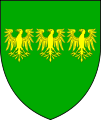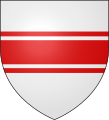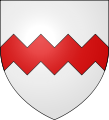Fess

In heraldry, a fess or fesse (from Middle English fesse, from Old French, from Latin fascia, "band")[1] is a charge on a coat of arms that takes the form of a band running horizontally across the centre of the shield.[2] Writers disagree in how much of the shield's surface is to be covered by a fess or other ordinary, ranging from one-fifth to one-third. The Oxford Guide to Heraldry states that earlier writers including Leigh, Holme, and Guillim favour one-third, while later writers such as Edmondson favour one-fifth "on the grounds that a bend, pale, or chevron occupying one-third of the field makes the coat look clumsy and disagreeable."[3] A fess is likely to be shown narrower if it is uncharged, that is, if it does not have other charges placed on it, and/or if it is to be shown with charges above and below it; and shown wider if charged. The fess or bar, termed fasce in French heraldry, should not be confused with fasces.
Diminutives
In English heraldry, two or more such charges appearing together on a shield are termed bars, though there are no definitive rules setting the width of the fess, the bar, nor their comparative width.[2] A shield of (often six or eight) horizontal stripes of alternating colour is called barry. Narrower versions of the bar are called barrulets ("little bars"), and when a shield of horizontal stripes alternating colour is composed of ten or more stripes, it is called barruly or burely instead of barry.[2] A cotise, defined as half the width of a barrulet, may be borne alongside a fess, and often two of these appear, one on either side of the fess.[2] This is often termed "a fess cotised" (also cottised, coticed or cotticed).[4] Another diminutive of the fess called a closet is said to be between a bar and barrulet, but this is seldom found.[2] A fess when couped ("cut off" at either end, and so not reaching the sides of the shield) can be called humetty, but this term is very rare in the Anglophone heraldries and is most often used of the cross.[citation needed]
Other uses
A shield party per fess (or simply per fess) is divided in half horizontally (in the manner of a fess). A charge placed horizontally may be termed fesswise or fessways, and two or more charges arranged in a horizontal row are blazoned in fess or in bar.
-
Tierced per fess
-
Three eagles in fess
-
A fleur-de-lys between two mullets in fess
-
A flaming arrow fesswise
Notable and unusual forms
A mural fess, that is a fess embattled and masoned of the field, can be seen in the arms of Suzanne Elizabeth Altvater.[5]
The arms of Baroness Fritchie provide an example of three Barrulets fracted and there conjoined to a Chevronel.[6]
See also
Gallery
-
Fess cottised
-
Two barrulets
-
Two bars gemelles
-
Fess dancetty
-
Party per fess
-
Barry of eight
-
Barry wavy
-
Barry nebuly
Notes
- ^ "Fess 1". American Heritage Dictionary of the English Language, 4th ed. Houghton Mifflin Company. 2000. Archived from the original on 2005-09-26. Retrieved 2009-03-29.
{{cite news}}: Unknown parameter|deadurl=ignored (|url-status=suggested) (help) - ^ a b c d e Woodcock & Robinson (1988), Oxford Guide to Heraldry, p. 60.
- ^ Woodcock & Robinson (1988), Oxford Guide to Heraldry, p. 58.
- ^ Parker, James (1894). "Cottise". A Glossary of Terms Used in Heraldry. Retrieved 2009-03-29.
- ^ "Suzanne Elizabeth Altvater Grant of Arms". The Public Register of Arms, Flags and Badges of Canada. The Canadian Heraldic Authority. 1998-10-29. Retrieved 2009-03-29.
- ^ "Heraldry of New Life Peers". The Heraldry Gazette (June 2007). The Heraldry Society: 3. 2007-11-24. Retrieved 2009-03-29.
Further reading
- Boutell, Charles (1890). Heraldry, Ancient and Modern: Including Boutell's Heraldry. London: Frederick Warne. OCLC 6102523
- Fox-Davies, Arthur Charles (1909). A Complete Guide to Heraldry. New York: Dodge Pub. Co. ISBN 0-517-26643-1. LCCN 09-23803
- Neubecker, Ottfried (1976). Heraldry: Sources, Symbols and Meaning. Maidenhead, England: McGraw-Hill. ISBN 0-07-046312-3.
- Volborth, Carl-Alexander von (1981). Heraldry: Customs, Rules and Styles. Poole, England: Blandford Press. ISBN 0-7137-0940-5. LCCN 81-670212
- Woodcock, Thomas and John Martin Robinson (1988). The Oxford Guide to Heraldry. Oxford: University Press. ISBN 0-19-211658-4. LCCN 88-23554
- Woodward, John and George Burnett (1892). Woodward's a treatise on heraldry, British and foreign. Edinburgh: W. & A. K. Johnson. ISBN 0-7153-4464-1. LCCN 02-20303












